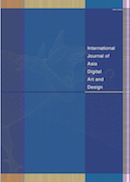All issues

Volume 22 (2018)
- Issue 4 Pages 1-
- Issue 2 Pages 38-
- Issue 1 Pages 1-
Volume 22, Issue 4
Displaying 1-3 of 3 articles from this issue
- |<
- <
- 1
- >
- >|
-
Zhipeng Feng, Kiyoshi Tomimatsu2018Volume 22Issue 4 Pages 1-8
Published: 2018
Released on J-STAGE: July 12, 2019
JOURNAL FREE ACCESSChinese traditional art has always taken a place in various art categories by virtue of its unique artistic charm and strong visual language. Therefore, the author produced a 10-minute traditional animation style clip by contemporary animation technology and presented the required design skills and performance elements. Based on the different interviewees using comparative analysis, contemporary animation can achieve traditional artistic aesthetics.View full abstractDownload PDF (13029K) -
Mingoo Kwak, Joon Seo Lee2018Volume 22Issue 4 Pages 9-16
Published: 2018
Released on J-STAGE: September 21, 2019
JOURNAL FREE ACCESSThe purpose of this research is to study the effectiveness of interactive data visualization in the design aspect. The prominent leaders of the mass media medium using data visualization, Bloomberg and The New York Times, are selected for this research study. In order to collect the latest data as a case study based, this research narrowed down to selecting articles consisting of data visualization written in the year between 2016 and 2017. Amongst these selections, a total of 174 articles are referenced as examples applying interactive elements of data visualization in news articles. Cases were categorized into types of interaction, and 5 cases were focused on each type. Each type is named after their functions by interactive; Showing Detailed Information, Relation of Data, Narrative, Data Classification, and Editorial. No matter which media have produced, all cases were applying 1 or more interactive of these 5 types in each article. The value we found throughout the research is as follow. First, interactive data visualization has been in use in the specialized field of news media. This explains that the news media now concentrate on utilizing data visualization in the main news section. Second, the interactive design style of data visualization considers user convenience and the presentation’s web space at the same time. Third, data visualization of the latest news graphic adopts the latest design trend while developing the existing methods. The data visualization types used in the print media is adopted by the digital medium with a hint of interactive elements, forming a new visualization with an introduction of the latest design trends and ever advancing technology. It is expected that interactive data visualization will continue to advance along with the fast-paced media environment and data technology. In this study, we studied data visualization examples that are actively interactive with users to better understand the different types of data visualization. Categorizing interactive types is to understand the current trends in data visualization design. Based on this research, we suggest the future direction in developing and advancing ways to design the interactive data visualization.View full abstractDownload PDF (2589K) -
Joon Seo Lee, Sang Hun Sul2018Volume 22Issue 4 Pages 17-23
Published: 2018
Released on J-STAGE: October 03, 2019
JOURNAL FREE ACCESSAn exclusive design strategy, converging public art and data analysis, has shown that media façade installed in an abandoned urban landscape can influence local community and people’s awareness at an individual level. Here, we used a media façade ‘Light across the bay’ which uses LED lights on the building to regenerate an abandoned area. (Figure 1) While the media façade was displayed for 54 months, we collected information on people’s awareness of the project through social network data (2,438,140 hashtags) to analyze their awareness of an abandoned urban landscape. Finally, we found that narrowing the awareness gap between the local community level and the individual level led to greater awareness of that urban area.View full abstractDownload PDF (7644K)
- |<
- <
- 1
- >
- >|